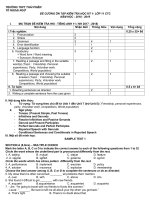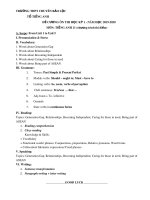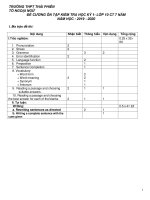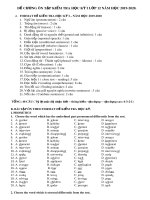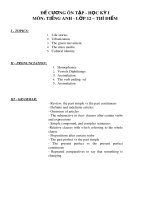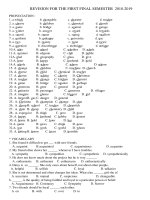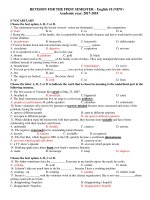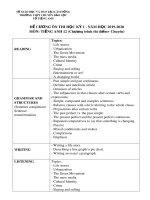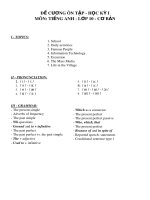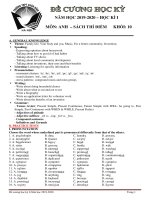Đề cương ôn tập học kì 1 môn Tiếng Anh 12 năm 2019-2020 - Trường THPT Chu Văn An (Thí điểm)
Bạn đang xem bản rút gọn của tài liệu. Xem và tải ngay bản đầy đủ của tài liệu tại đây (420.71 KB, 10 trang )
ĐỀ CƯƠNG ÔN TẬP HỌC KỲ I
MÔN: TIẾNG ANH LỚP 12 – THÍ ĐIỂM
I TOPICS:
1.
2.
3.
4.
5.
Life stories
Urbanization
The green movement
The mass media
Cultural identity
II PRONUNCIATION:
1. Homophones
2. Vowels Diphthongs
3. Assimilation
4. The verb ending ed
5. Assimilation
III GRAMMAR:
Review: the past simple vs the past continuous
Definite and indefinite articles
Omission of articles
The subjunctive in that clauses after certain verbs
and expressions
Simple compound, and complex sentences
Relative clauses with which referring to the whole
clause
Prepositions after certain verbs
The past perfect vs the past simple
The present perfect vs the present perfect
continuous
Repeated comparatives to say that something is
changing
III Practice:
Mark the letter A, B, C or D on your answer sheet to indicate the most suitable response to each of the
following exchanges.
Question 1: Mike: “_______”
– Phương: “Thanks, I will.”
A. Thank you for your help.
B. Wish you a happy journey.
C. Give my best wishes to your parents. D. You got the first prize. Congratulation!
Question 2: Sylvia: “Do you mind if I use your dictionary?”
Trang: “Of course not. _______.”
A. I have a dictionary
B. It’s over there
C. Don’t do thatD. I’m sorry I can’t
Mark the letter A, B, C or D on your answer sheet to indicate the word(s) OPPOSITE in meaning to the
underlined part(s) in each of the following questions.
Question 3: After many months of grueling work and painful injuries to her shoulder and back, Susan realized that
her dream of swimming the English Channel was unattainable.
A. impossible B. realistic C. confused D. unachievable Question 4: Head Coach Park Hang–Seo along with his
football team has achieved unprecedented results so far.
A. enormous
B. outstanding C. phenomenal D. commonplace
Mark the letter A, B, C or D on your answer sheet to indicate the word(s) CLOSEST in meaning to the underlined
word(s) in each of the following questions.
Question 5: I find it difficult to remain neutral while he is concerned about the matter.
A. objective
B. positive
C. negative
D. middle
Question 6: A lot of superstitious practice in a country can be a major impediment to its economic development.
A. obstacle
B. assistance
C. impetus
D. encouragement
Read the following passage and mark the letter A, B, C or D on your answer sheet to indicate the best option
for each of the blanks.
SETTLING IN OUR UNIVERSITY
The university campus is like one big village where thousands of students live, work and relax surrounded by
rolling green fields. It is the centre of the student (7) _______ in all its variety. While it is basically a place for
young people, there are a (8) _______ of family flats and children are never far away. People come to live here
from all over the world, so members of different cultures and speakers of different languages live next door to each
other. One house has had special structural (9) _______ to make it suitable for students with disabilities. Most first
year students live on campus. It's the easiest way to meet people when you first arrive and there’s always somebody
to (10) _______. It’s a busy, lively place, but because the campus is in the middle of parkland, you can (11)
_______ off and be alone if you want to.
Question 7:
Question 8:
Question 9:
Question 10:
A. society
A. block
A. changes
A. get round to
B. company
B. quantity
B. adjustments
B. drop in on
C. community D. connection
C. pile D. number
C. exchanges D. alterations
C. face up to D. go in for
Question 11:
A. limp B. crawl
C. wander
D. march
Mark the letter A, B, C or D on your answer sheet to indicate the sentence that best combines each pair of
sentences in the following questions.
Question 12: You may be very intelligent. You should be careful about what you are going to do.
A. No matter why intelligent you may be, you should be careful about what you are going to do.
B. No matter what intelligent you may be, you should be careful about what you are going to do.
C. No matter how intelligent you may be, you should be careful about what you are going to do.
D. No matter whatever intelligent you may be, you should be careful about what you are going to do.
Question 13: My sister didn’t leave the house key. As a result, I can’t be cooking lunch now.
A. If my sister have left the house key, I could have been cooking lunch now.
B. If my sister had left the house key, I could have been cooking lunch now.
C. If my sister had left the house key, I could be cooking lunch now.
D. If my sister left the house key, I could be cooking lunch now.
Read the following passage and mark the letter A, B, C or D on your answer sheet to indicate the correct
answer to each of the question.
Mountaineers have noted that as they climb, for example, up to the 12,633–foot Humphreys Peak in the San
Francisco Peaks in Arizona, plant life changes radically. Starting among the cacti of the Sonoran Desert, one climbs
into a pine forest at 7,000 feet and a treeless alpine tundra at the summit. It may seem that plants at a given altitude
are associated in what can be called “communities” – groupings of interacting species. The idea is that over time,
plants that require particular climate and soil conditions come to live in the same places, and hence are frequently
to be found together. Scientists who study the history of plant life are known as paleobotanists, or paleobots for
short. They build up a picture of how groups of plants have responded to climate changes and how ecosystems
develop. But are these associations, which are real in the present, permanent?
A great natural experiment took place on this planet between 25,000 and 10,000 years ago, when small changes in
the earth’s orbit and axis of rotation caused great sheets of ice to spread from the poles. These glaciers covered
much of North America and Europe to depths of up to two miles, and then, as the climate warmed, they retreated.
During this retreat, they left behind newly uncovered land for living things to colonize, and as those living things
moved in they laid down a record we can read now. As the ice retreated and plants started to grow near a lake, they
would release pollen. Some would fall into the lake, sink to the bottom, and be incorporated into the sediment. By
drilling into the lake bottom it is possible to read the record of successive plant life around the lake. The fossil
record seems clear; there is little or no evidence that entire groups of plants moved north together. Things that lived
together in the past don’t live together now, and things that live together now didn’t live together in the past. Each
individual organism moved at its own pace. The fossil record seems to be telling us that we should be
thinking about preserving species by giving them room to maneuver – to respond to environmental changes.
Question 14: What is the second paragraph mainly about?
A. Plant migration after the ice age.
B. The effects of the ice age on plants.
C. The need to develop a new approach to environmental issues.
D. Communities of plants live at different altitudes.
Question 15: The word “radically” in paragraph 1 is closest in meaning to _______.
A. quickly B. variably C. dramatically D. demonstrably Question 16: The author mentions “cacti” and “a treeless
alpine tundra” in paragraph 1 to illustrate
_______.
A. changes in climate
B. the effects of the ice age
C. plant immigration
D. communities of plants
Question 17: The word “which” in last sentence of paragraph 1 refers to _______.
A. the developments of ecosystems
B. plant life changes
C. the current theories of ecosystem
D. the responses of plants to climate changes
Question 18: The word “successive” in paragraph 2 is closest in meaning to _______.
A. consecutive B. accumulativeC. extinct
D. following
Question 19: The passage states that by drilling into the lake bottom it is possible to find successive fossils of
_______.
A. plant life B. sediment D. ice D. pollen Question 20: Which of the following can be inferred from the passage?
A. That the migratory patterns of plants are dependent upon changes in climate.
B. That current associations of plants are similar to those in the past.
C. That modern conservation methods should consider the migratory patterns of plants.
D. That another ice age is likely to occur at some time.
Mark the letter A, B, C or D on your answer sheet to indicate the sentence that is CLOSEST in meaning to
each of the following questions.
Question 21: “I won’t return the book you lent me until tomorrow afternoon,” said Lucy. A. Lucy told me to return
the book she had lent me until the next afternoon
B. Lucy promised to return the book I had lent her until the next afternoon.
C. Lucy offered to return the book I had lent her until the next afternoon.
D. Lucy refused to return the book I had lent her until the next afternoon.
Question 22: But for two minor mistakes, I would have got full marks for the test.
A. Had I made two minor mistakes, I would have got full marks for the test.
B. If I didn’t make these two minor mistakes, I would have got full mark for the test.
C. If the mistakes hadn’t been minor, I could have got full marks for the test.
D. I would have got full marks for the test if there hadn’t been these two minor mistakes.
Question 23: Many people are afraid of sharks, but they rarely attack people.
A. Sharks rarely attack people because many people are afraid of them.
B. Rarely attacked by sharks, many people are, therefore, afraid of them.
C. Many people are afraid of sharks because they are dangerous.
D. Although sharks rarely attack people, many people are afraid of them.
Mark the letter A, B, C or D on your answer sheet to show the underlined part that needs correction in each
of the following questions.
Question 24: Though artist Tatun was totally blind in one eye and had only slight vision in another, he became an
internationally renowned jazz musician.
A. Though B. only slight C. another D. internationally Question 25: The abilities to work hard, follow directions,
and thinking independently are some of the criteria for success in the work place.
A. to work
B. thinking
C. are D. for success
Question 26: Photographs from a satellite are frequently used to generate the information is needed to
produce a map.
A. are B. used C. generate
D. is needed
Read the following passage and mark the letter A, B, C or D on your answer sheet to indicate the correct
answer to each of the questions.
Considered the most influential architect of his time, Frank Lloyd Wright (1867–1959) was born in the small rural
community of Richland Center, Wisconsin. He entered the University of Wisconsin at the age of 15 as a special
student, studying engineering because the school had no course in architecture. At the age of 20 he then went to
work as a draftsman in Chicago in order to learn the traditional, classical language of architecture. After marrying
into a wealthy business family at the age of 21, Wright set up house in an exclusive neighborhood in Chicago, and
after a few years of working for a number of architectural firms, set up his own architectural office.
For twenty years he brought up a family of six children upstairs, and ran a thriving architectural practice of twelve
or so draftsmen downstairs. Here, in an idyllic American suburb, with giant oaks, sprawling lawns, and no fences,
Wright built some sixty rambling homes by the year 1900. He became the leader of a style known as the “Prairie”
school – houses with low–pitched roofs and extended lines that blended into the landscape and typified his style of
“organic architecture”.
By the age of forty–one, in 1908, Wright had achieved extraordinary social and professional success. He gave
countless lectures at major universities, and started his Taliesin Fellowship – a visionary social workshop in itself.
In 1938 he appeared on the cover of Time magazine, and later, on a two cent stamp. The most spectacular buildings
of his mature period were based on forms borrowed from nature, and the intentions were clearly romantic, poetic,
and intensely personal. Examples of these buildings are Tokyo’s Imperial Hotel (1915–22: demolished 1968), and
New York City’s Guggenheim Museum (completed 1959). He continued working until his death in 1959, at the age
of 92, although in his later years, he spent as much time giving interviews and being a celebrity, as he did in
designing buildings. Wright can be considered an essentially idiosyncratic architect whose influence was immense
but whose pupils were few.
Question 27: With which of the following subject is the passage mainly concerned?
A. The development of modern architecture in America.
B. The contributions of the “Prairie” School to modern architecture.
C. The life and achievements of a famous architect.
D. The influence of the style of “organic architecture” in America.
Question 28: Frank Lioyd Wright first worked as a draftsman _______.
A. because he lived above his shop and employed draftsman for twenty years.
B. to learn the language of architecture
C. because that is what he studied at the University of Wisconsin
D. because that is the work of new employees in architectural firms
Question 29: The word “some” in paragraph 2 is closest in meaning to _______.
A. exactly
B. over C. nearly
D. around
Question 30: According to the passage, an idyllic American suburb is _______.
A. based on forms borrowed from nature
B. blended into the landscape
C. giant oaks, sprawling lawns, and no fences
D. houses with low–pitched reefs and extended lines
Question 31: The word “itself” in paragraph 3 refers to _______.
A. social workshop
B. He C. Taliesin Fellowship D. major universities
Question 32: The word “idiosyncratic” in last sentence is closest in meaning to _______.
A. idiotic
B. idealistic
C. individualistic
D. independent
Question 33: Which of the following can be inferred from the passage?
A. The Taliesin Fellowship was a grant of money.
B. Many of Wright’s architectural ideas have not been taken up by others.
C. Wright used his wife’s money to set up his own architectural office in an exclusive neighborhood.
D. Some of Wright’s most notable buildings have been demolished because they were not popular.
Question 34: All of the following about Frank Lioyd Wright are true EXCEPT ______. A. he became the leader of
a style known as “organic architecture”
B. he died at the age of 92
C. he commenced university studies at the age of 15
D. some of his most spectacular buildings were not in American
Mark the letter A, B, C or D on your answer sheet to indicate the word whose underlined part is not
pronounced differently from that of the rest in each of the following questions.
Question 35:
A. informs
B. mistakes
C. combines
D. complains
Question 36:
A. toothache
B. church
C. chemistry
D. stomach
Mark the letter A, B, C or D on your answer sheet to indicate the word that differs from the rest in the
position of the main stress in each of the following questions.
Question 37:
A. controller
B. popularity
C. embarrassingD. convenient
Question 38:
A. exceeding
B. existence
C. example
D. carefully
Mark the letter A, B, C or D on your answer sheet to indicate the correct answer to each of the questions.
Question 39: Only when you become a parent _______ what true responsibility is.
A. don’t you understand
B. will you understand
C. you understand
D. you will understand
Question 40: We regret to inform you that Ms. Markowitz’s workshop on public speaking _______
postponed until next week.
A.
B.
C.
D.
has been
were
would be
being
Question 41: I don’t think students who volunteer in high school will continue to volunteer throughout their lives,
_______?
A.
B.
C.
D.
don’t they
will they
do they
won’t they
Question 42: Children are told to be _______ for the whole week and promised to be rewarded at
weekends.
A. obedient
B. obedience
C. disobedient
D. obey
Question 43: _______, one tin will last for at least six weeks.
A. Using economical
B. Used economically
C. Used economical
D. Using economically
Question 44: The audience, _______, enjoyed the performance.
A. they themselves were students
B. most of whom were students
C. most of them were students
D. they were mostly students
Question 45: It is the organizer’s request that _______.
A. everyone arrive here in time
B. everyone shall arrive here in time
C. everyone must arrive here in time
D. everyone arrives here in time
Question 46: The party wasn’t very ________, so almost all his friends left early.
A. interested
B. boring
C. bored
D. interesting
Question 47: The people awaiting their delayed flight had to spend the night _______ on the cold floor.
A.
B.
C.
D.
slept
having slept
to sleep
sleeping
Question 48: I never take much on holiday with me, just _______ clothes and a couple of books.
A. a little
B. few
C. a few
D. little
Question 49: The more you talk about the matter, ______.
A.
B.
C.
D.
the worse the situation seems
the worse seem the situation
the situation seems worse
the situation seems the worse
Question 50: Where _______ is the commonest form of colour – blindness.
A. red and green are not easily distinguished
B. they are not easily distinguished red and green
C. are the red and green not easily distinguished
D. are not easily distinguished red and green
Question 1
C
Question 2
B
Question 3
B
Question 4
D Question 5
A
Question 6
A
Question 7
C
Question 8
D
Question 9
D Question 10
B
Question 11 C
Question 12
C
Question 13
C
Question 14
C Question 15
C
Question 16 D
Question 17
D
Question 18
A
Question 19
D Question 20
C
Question 21 D
Question 22
D
Question 23
D
Question 24
C Question 25
B
Question 26 D
Question 27
C
Question 28
B
Question 29
D Question 30
C
Question 31 C
Question 32
C
Question 33
B
Question 34
A Question 35
B
Question 36 B
Question 37
B
Question 38
D
Question 39
B Question 40
A
Question 41 B
Question 42
A
Question 43
B
Question 44
B Question 45
A
Question 46 D
Question 47
D
Question 48
C
Question 49
A Question 50
A
